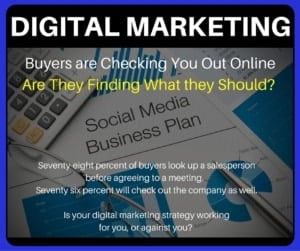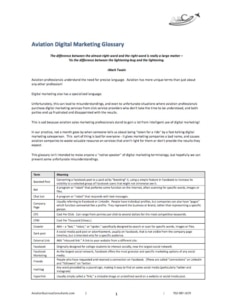Aviation Digital Marketing Glossary
Aviation professionals understand the need for precise language. Aviation has more unique terms than just about any other profession! Digital marketing also has a specialized language.
Unfortunately, this can lead to misunderstandings, and even to unfortunate situations where aviation professionals purchase digital marketing services from slick service providers who don’t take the time to be understood, and both parties end up frustrated and disappointed with the results.
This is sad because aviation sales marketing professionals stand to gain a lot from intelligent use of digital marketing!
In our practice, not a month goes by when someone tells us about being “taken for a ride” by a fast-talking digital marketing salesperson. This sort of thing is bad for everyone – it gives marketing companies a bad name, and causes aviation companies to waste valuable resource on services that aren’t right for them or don’t provide the results they expect.
[embedyt] https://www.youtube.com/watch?v=YjjPSHOX9c8[/embedyt]This glossary isn’t intended to make anyone a “native speaker” of digital marketing terminology, but hopefully we can prevent some unfortunate misunderstandings. Click here to download the printable digital marketing glossary.
The difference between the almost-right word and the right word is really a large matter –
‘tis the difference between the lightening-bug and the lightening.-Mark Twain
Here’s the Glossary: (Or Download a Printable version here.)
| Term | Meaning |
| Boosted Post | Converting a Facebook post to a paid ad by “boosting” it, using a simple feature in Facebook to increase its visibility to a selected group of Facebook users that might not otherwise see it. |
| A program or “robot” that performs some function on the Internet, often scanning for specific words, images or files. | |
| Chat bot | A program or “robot” that responds with text messages. |
| Company Page | Usually referring to Facebook or LinkedIn. People have individual profiles, but companies can also have “pages” which function somewhat like a profile. They represent the business or brand, rather than representing a specific person. |
| CPC | Cost Per Click. Can range from pennies per click to several dollars for the most competitive keywords. |
| CPM | Cost Per Thousand (Views.) |
| Crawler | AKA – a “bot,” “robot,” or “spider,” specifically designed to search or scan for specific words, images or files. |
| Dark post | A social media paid post or advertisement, usually on Facebook, that is not visible from the company page timeline, but is intended only for a specific audience. |
| External Link | AKA “inbound link.” A link to your website from a different site. |
| Originally designed for college students to interact socially, now the largest social network. | |
| Facebook Marketing | As the largest social network, Facebook offers the most granular and specific marketing options of any social media. |
| Friends | People who have requested and received a connection on Facebook. (These are called “connections” on LinkedIn and “followers” on Twitter. |
| Hashtag | Any word preceded by a pound sign, making it easy to find on some social media (particularly Twitter and Instagram) |
| Hyperlink | Usually simply called a “link,” a clickable image or underlined word on a website or social media post. |
| IM | Instant messaging or online chat. |
| Image Tag | Words identifying an image. Usually not seen on the website but placed in the underlying code to help search engines and bots identify and index images. |
| Impression | Each time an ad is viewed in a browser on any device – desktop, tablet or phone. Note – it doesn’t necessarily have to be clicked or acted upon to count as an impression. |
| Inbound Link | AKA “External Link.” A link to your website from a different site. |
| Inbound Marketing | A strategy that focuses on attracting customers via company-related internet content and acquiring their contact information in exchange for high-value information. |
| Instant Messaging | A type of online chat – real-time text messages transmitted over the Internet. |
| Keyword Density | The number of times a keyword appears in a post. |
| Keywords | Words or phrases that capture the essence of a topic or document, used by search engines (Google, Yahoo, etc.) to find the most relevant material to people searching. |
| Landing Page | A page intended to be the first one viewed on a website. Could be the home page, but usually built for a specific purpose. |
| Lead Magnet | A mechanism on a website or social media encouraging people to subscribe to future updates (or marketing) in exchange for high-value information, such as a buyer’s guide or tip sheet. |
| Link | AKA “hyperlink,” a clickable image or underlined word on a website or social media post. |
| Link Farm | A site built specifically for the purpose of creating external links to boost search engine results for client sites. Often created as a directory or low-quality blog with many gratuitous links. |
| LinkedIn Marketing | Using the LinkedIn social media platform for marketing, either by searching for prospects based on specific criteria or by publishing paid ads to specific individuals. |
| LinkedIn Articles | Longer and more complex that LinkedIn Updates, the Articles function allows for a complex blog hosted on the LinkedIn social media platform. |
| LinkedIn Updates | Short, simple social media updates on the LinkedIn platform. |
| MeetEdgar | A social media posting and aggregating tool. |
| Messenger marketing | Using chat, IM or Facebook Messenger for marketing purposes, usually by broadcasting text messages and responding to text messages using a bot or computer program. |
| Meta tags | Meta tags are words and phrases attached to an item on the web, such as a web page or image (see “image tags”) to help search engines and other bots to scan and index the material. |
| Organic Listings | Search engine results that are not paid ads. |
| Organic Results | See organic listings. Unpaid search engine results. |
| Outbound Marketing | Reaching out to prospects with direct mail, telephone, connecting on social media, usually unsolicited. |
| Paid Ad | An ad on any social media or search engine that has been paid for. |
| Paid Listing | A listing in any directory that was paid for. |
| Pay Per Click | Terms of sale of an online advertisement that include an agreement to pay a specific amount each time a link or image is clicked, presumably bringing visitors to your own website or product page. |
| Permission Marketing | AKA “Inbound Marketing.” |
| Personal Page | AKA “Profile” on a social media channel. Personal pages with a minimum of information are required to log into Facebook and LinkedIn, where permissions are based on your personal account. |
| Podcast | Audio (or video) files, usually on a specific topic, usually a series with a subscription, hosted by iTunes, Stitcher, or Google Play. Popular aviation podcasts are hosted by Aviation Week, The Airplane Geeks, and others. |
| PPC | Pay Per Click |
| Profile | AKA “Personal Page” on a social media channel. Personal pages with a minimum of information are required to log into Facebook and LinkedIn, where permissions are based on your personal account. |
| Rankings | Where your site or page appears in the search results, AKA “search results” aka “search page” aka “SERP.” The first five spaces or the first page of results is the most coveted because most Internet searchers usually don’t search past the first page of results. |
| Redirect | Code that causes a visitor to find himself on a different web page. Often used as a shortcut for convenience or marketing. For example, if you type in ABCI1.com you will be redirected to AviationBusinessConsultants.com. |
| Results Page | AKA “search results” aka “search page” aka “SERP.” The page that appears after you type a specific keyword or phrase into a search engine. The first five spaces or the first page of results is the most coveted because most Internet searchers usually don’t search past the first page of results. |
| Robot | A program or “bot” that performs some function on the Internet, often scanning for specific words, images or files. |
| ROI | Return on Investment. One way to calculate a return on investment for digital marketing is to review sales made during the year, |
| RSS | Real Simple Syndication – Usually used to re-use content on your website to another location. (To automatically publish to a podcast or social media feed, for example.) |
| Search Engine | Google, Bing, Yahoo, etc. A web page that web visitors use to search for pages, videos or images on a particular topic, using “search terms” AKA “keywords.” |
| Search Term | AKA “keyword” |
| SEM | Search engine marketing. Techniques used to make your content show up more prominently in search results. Includes paid search options like Pay Per Click ads, optimizing content for better organic search results, (SEO) and adding more content to attract the attention of the search engines. |
| SEO | Search Engine Optimization. Visible and invisible changes made to a website, web pages, images, and other parts of a website to make it easier for the search engines to find and index. This helps visitors using search engines to find your website more easily. |
| SEO Audit | An evaluation of your website to find ways to make it perform better search engines. The starting point of any good Search Engine Optimization program. |
| SERP | Search Engine Results Page. The page that pops up when people search for a particular keyword. |
| Sitemap | An outline of the pages on your website, designed to help people or (more often) search engines find their way around your site. An XML sitemap is built in a programming language and is intended for search engines. |
| SlideShare | Owned by LinkedIn, a social media network designed to help people share and find slide presentations on specific topics. Can be used to explain topics or even sell products. |
| Social Media | Any website or app that helps people interact with one another. The most popular social media networks for aviation industry professionals are LinkedIn, Facebook, Twitte Slideshare and a few others. |
| Social Network | See Social Media. Could also be used to describe all of your connections on a particular social media platform or across all platforms. (ABCI’s company page has a social network of 5,200 on Facebook, I’m personally connected with 2,785 on Linkedin.) |
| Spider | AKA – a “bot,” “robot,” or “crawler,” specifically designed to search or scan for specific words, images or files. |
| Subscribe | A key component of inbound marketing. When a person “friends,” “likes” or “follows” you on a social media platform, they are essentially subscribing to see updates from you in the future. You can also set up “lead magnets” on your website inviting visitors to subscribe, usually in exchange for some high-value information they want. |
| Tweet | A post or update on Twitter. |
| Tweetup | A meeting where people who are connected on social media (usually Twitter) meet. There are often Tweetups for social media connections at major aviation conventions. |
| A social media platform that emphasizes short updates. (Twitter.com) | |
| Twitter Marketing | Posts on Twitter designed to advertise a product or service. |
| UGC | User-Generated Content. When you enable comments on a blog post or run a photo contest, you are asking your website visitors or social media connections to submit “User Generated Content.”
Social media is almost entirely composed of UGC. |
| Usability Audit | An audit of your website based on industry-standard practices. For example, most people look for a search or shopping cart function in the upper right corner, and most people look for underlined links. A Usability Audit evaluates how well the website conforms to these conventions. |
| User Generated Content | AKA “UGC” – When you enable comments on a blog post or run a photo contest, you are asking your website visitors or social media connections to submit “User Generated Content.”
Social media is almost entirely composed of UGC. |
| Viral Marketing | Content created with the intention of being shared on social media. “Viral” is meant to describe how a virus moves from one organism to another. But in digital marketing, the “virality” of a post is based on how many people share it with their own social networks. |
| Web 2.0 | Web 2.0 does not refer to an update to any technical specification, but to changes in the way Web pages are designed and used.
A Web 2.0 website may allow users to interact and collaborate with each other in a social media dialogue as creators of user-generated content in a virtual community, in contrast to the first generation of Web 1.0-era websites where people were limited to the passive viewing of content. Examples of Web 2.0 features include social networking sites and social media sites (e.g., Facebook), blogs, wikis, folksonomies (“tagging” keywords on websites and links), video sharing sites (e.g., YouTube), hosted services, Web applications (“apps”), collaborative consumption platforms, and mashup applications. |
| Web Conference | AKA “Webinar” – A seminar delivered over the Internet, so that participants can hear audio and see video or slides, and usually participate by asking questions via a chat function. |
| Webinar | AKA “Web Conference” – A seminar delivered over the Internet, so that participants can hear audio and see video or slides, and usually participate by asking questions via a chat function. |
| Website Audit | Website Audits can be based on Search Engine Optimization (to improve the number of visitors) or Usability (to help turn those visitors into customers, clients, passengers, etc. The intention is to improve the marketing performance of a website. |
| Wiki | A website that allows collaborative editing of its content by users. |
| Wikipedia | The world’s largest wiki, an online user-generated encyclopedia. People and things can be submitted for inclusion into Wikipedia and are confirmed by a board of volunteer editors who enforce a set of guidelines. It can be a great marketing strategy to create a Wikipedia entry. |
| XMP Sitemap | AKA “sitemap.” An outline of the pages on your website, designed to help search engines find their way around your site. |
| YouTube | A social media platform where participants view or submit videos. |
 Did you know . . .ABCI offers Digital Marketing for Aviation companies?
Did you know . . .ABCI offers Digital Marketing for Aviation companies?
Other Digital Marketing Topics
Aviation Digital Marketing Glossary
Aviation Digital Marketing – Please Enjoy Responsibly!
6 Prospecting Methods Using Aviation Digital Marketing
The Digital Citizen – Why You Should Hire One (Or Be One!)
A Quick Tip for Getting More Online Reviews!
#FollowFriday – Aviation Inbound Marketing & Sketchy Prospects
Hashtag Marketing in Aviation Industry
Podcast: Play in new window | Download
Subscribe: Spotify | Amazon Music | RSS

